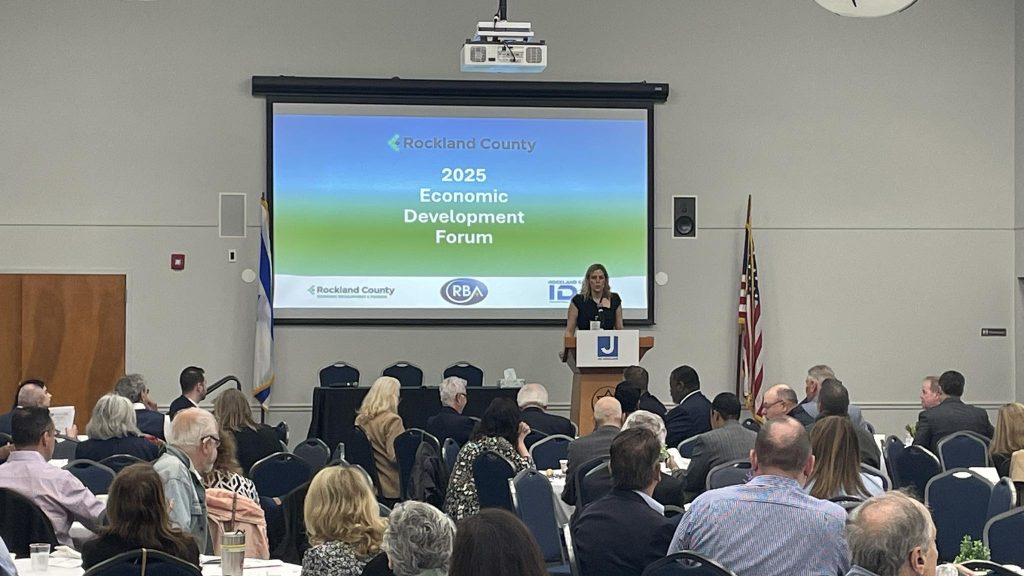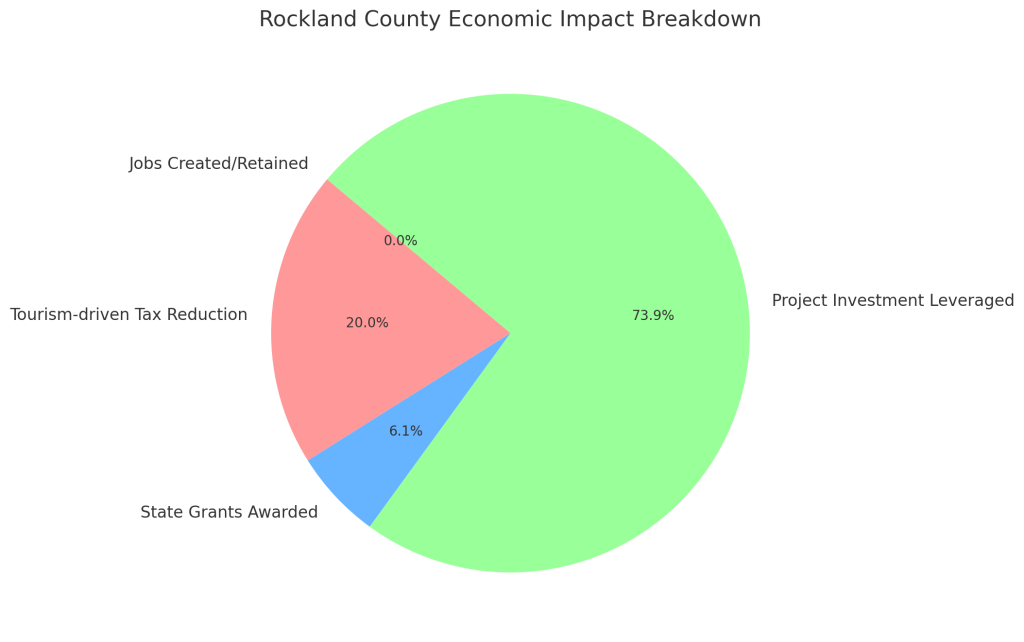
By Tom Ossa
West Nyack, NY – Rockland County’s public and private sector leaders convened recently for a comprehensive economic development forum that underscored the region’s achievements – while also laying bare the mounting challenges that could threaten the future vitality of the County.
County Executive Ed Day opened the event by emphasizing the tangible impacts of strategic economic initiatives, noting that tourism-driven development alone contributes to an average tax burden reduction per resident of $500 — a significant figure in a county of approximately 339,000 people.
“We need the business community’s support. Every proposal we put forward gets pushback. If we don’t stand together, we risk standing still.”
~ Teresa Kenny, Orangetown Supervisor
The forum brought together state officials, economic development experts, town supervisors, and business leaders, offering a wide-ranging dialogue that dissected the complexities of maintaining economic competitiveness in Rockland while preserving its unique character and natural assets.

State and Regional Support
Representatives from Empire State Development (ESD) and the Mid-Hudson Regional Economic Development Council (REDC) highlighted Rockland’s participation in the state’s consolidated funding application (CFA) process. Since the CFA’s inception, Rockland has secured 108 awards totaling $51.3 million, leveraging over $625 million in total project investments and creating or retaining more than 8,000 jobs.
The REDC identified Rockland as a priority area for sectors including life sciences, advanced manufacturing, distribution, and green technologies. The Downtown Revitalization Initiative (DRI) and New York Forward programs were also spotlighted as vehicles for transforming key hamlets and villages, as seen in Haverstraw and Nyack.
Urgent Call for Housing and Workforce Solutions
“Housing is economic development. If we don’t get this right, we won’t have the workforce or the customer base to sustain our future.”
~ Adam Bosch, Hudson Valley Pattern for Progress
Adam Bosch, President of Hudson Valley Pattern for Progress, delivered a sobering analysis of the county’s housing crisis. In the past five years, Rockland’s median home price surged from $417,000 to $665,000, far outpacing wage growth and effectively locking out first-time buyers and young families. He warned that this affordability gap, combined with restrictive zoning and high parking requirements, is fueling outward migration and undermining the region’s workforce and commercial base.
“Housing is economic development,” Bosch asserted, urging local governments to revise zoning codes, incentivize adaptive reuse of underutilized properties, and embrace a growth mindset that balances preservation with progress.
Local Efforts to Retain Residents and Businesses
“Quality of life starts with our residents. If the people of Rockland don’t buy into what we’re selling, nobody else will.”
~ Jenna Nazario
Jenna Nazario, Rockland’s Director of Economic Development, detailed how the county is leveraging ARPA funds to invest in affordability, open space, and infrastructure upgrades. She emphasized that quality of life, location, and education remain the county’s core selling points, but acknowledged that retaining young families and attracting new residents requires a willingness to rethink traditional development models.
The five Town supervisors also joined for a panel discussion, and echoed these themes, each presenting localized challenges and opportunities:
- Clarkstown – George Hoehmann: Clarkstown is advancing mixed-use projects at the Shops at Nanuet and around its TOD zone, while facing difficult conversations about the future of the Palisades Center Mall. He indicated that before Spinoza took over the mall property, $50 million dollars of equity has been extracted, and bills were not being paid. However, Hoehmann indicated that new management in the form of Spinoso Real Estate Group is faring better. “They’re paying their bills.”
- Ramapo – Michael Specht: Ramapo is grappling with rapid population growth and a mismatch in housing supply, prompting plans to overhaul outdated infrastructure and pursue comprehensive zoning reforms. “Outdated infrastructure is suffocating our communities. We need serious investment and state cooperation to fix it.”
- Haverstraw – Howard Phillips: and Stony Point stressed their geographic disadvantages, limited by aging state routes and distant from major highways except route 9W, yet underscored efforts to capitalize on their Hudson River access, affordable housing stock, and recreation assets. “We need to find ways to keep the people who built this community here. They shouldn’t have to leave because they can’t afford to stay.”
- Stony Point – Jim Monaghan: Also confirmed the same challenges encountered by the Town of Haverstraw, he indicated that the Town enacted a river and rail round field redevelopment zone, which attracted a lshipping company called The Holding Group, which is using Stony Point’s loading dock next to the Lovett plant in order to ship green energy projects and materials.
- Orangetown – Teresa Kenny: highlighted adaptive reuse projects such as Blue Hill Plaza and the Pfizer site, while acknowledging resistance to new housing proposals from some residents.
The attendees, toward the end of the panel, took a moment to applaud outgoing Supervisor Monaghan, who recently announced that he will not seek re-election> Several officials also noted the Supervisor’s diligent and tireless work over the past decade in Stony Point.
More Quotes from Speakers and Panelists:
Jenna Nazario, Rockland County Director of Economic Development, Tourism & Film:
- “We have to look at our infrastructure, our environment, our affordability. ARPA gave us the opportunity to make real change.”
- “Quality of life starts with our residents. If the people of Rockland don’t buy into what we’re selling, nobody else will.”
- “Rockland is the gateway to the Hudson Valley. We’re 30 miles from NYC, yet we still offer a balance of affordability and quality of life.”
- “We’re about to celebrate 250 years of history—Rockland’s story is America’s story.”
Adam Bosch, President of Hudson Valley Pattern for Progress:
- “Housing is economic development. If people can’t live here, they can’t work here, and businesses can’t thrive.”
- “Adaptive reuse isn’t optional in Rockland—it’s essential. You can’t build out, so you have to build smart.”
- “Government can’t sit back and wait for economic development to happen. It has to play an active role at every level.”
Al Samuels, Rockland Business Association:
- “Economic development is our future. If we don’t bring in more commercial development, the burden will only get heavier on residents.”
- “Rockland County went from being the most fiscally stressed county in New York to number one in fiscal strength. That’s transformation.”
- “When others hesitated, we (the RBA) stood up for the Tappan Zee Bridge replacement. We had to make tough decisions for the future of Rockland.”
- “Economic development doesn’t always come easy. Sometimes you need to take on the third rail issues others avoid.”
Ken Zebrowski, President of the Rockland Business Association:
- “If we don’t look to the future, we risk stagnation. Growth is not a threat, it’s an opportunity.”
- “We have the infrastructure, but we need to reinvent our downtowns and support both large companies and small businesses.”
- “The biggest challenge is overcoming fear and angst about change. The RBA can help bring people together with data and facts.”
Howard Phillips, Supervisor of Haverstraw:
- “We need to find ways to keep the people who built this community here. They shouldn’t have to leave because they can’t afford to stay.”
- “Infrastructure is our Achilles heel. Without major upgrades, we risk becoming an isolated community.”
Teresa Kenny, Supervisor of Orangetown:
- “When it comes to housing, I bring the chart. Our school enrollments are dropping, and we need to face the reality.”
- “We need the business community’s support when we approve good projects. Too often the loudest voices are the most resistant.”
George Hoehmann, Supervisor of Clarkstown:
- “If we don’t proactively plan development, we risk stagnation and decay. Someone is going to develop that land—it’s better to be in control of it.”
- “Workforce housing is no longer a luxury—it’s a necessity. Without it, our employers can’t find workers.”
Michael Specht, Supervisor of Ramapo:
- “We have a housing crisis. And not just for large families. We need to rethink our zoning to allow smaller units, too.”
- “Outdated infrastructure is suffocating our communities. We need serious investment and state cooperation to fix it.”
A Call for Unity and Boldness
Throughout the forum, a consistent refrain emerged: Rockland must confront its internal divides, embrace regional cooperation, and be proactive in addressing the demographic, fiscal, and economic headwinds it faces.
Al Samuels, CEO of the Rockland Business Association and a board member of the REDC, reminded attendees of the RBA’s historic role in advocating for transformative projects, including the creation of the county’s IDA and the replacement of the Tappan Zee Bridge. He challenged civic and business leaders to step up once again to support necessary — if sometimes unpopular — changes.
Ken Zebrowski, President of the RBA, urged a future-facing approach, noting, “The biggest challenge for Rockland County is how are we going to grow, progress, and reinvent ourselves while overcoming the challenges of being a suburban county.”
Shiela Keenan, Principal of Simplisk, who founded the Main Street Marketplace, later wrote to Rockland News: “While it’s clear Rockland faces challenges, some universal to modern municipalities and some unique to us, it was heartening to see the high level of collaboration demonstrated at today’s Economic Forum. State, regional and local entities seem unified and forward-looking, and it was refreshing to witness positive interplay between the county executive, town supervisors and economic development and tourism leaders.”
The general consensus of all the speakers and panelists: Collaboration, creative problem-solving, and a shift in the local conversation from fear-based resistance to pragmatic, community-centered planning – will be the keys to moving the County’s economic prospects in the right direction.
